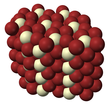Cerium(III) bromide
| |||

| |||
| Names | |||
|---|---|---|---|
| IUPAC names
Cerium(III) bromide
Cerium tribromide | |||
| Other names
Cerous bromide
| |||
| Identifiers | |||
3D model (
JSmol ) |
|||
| ChemSpider | |||
ECHA InfoCard
|
100.034.936 | ||
| EC Number |
| ||
PubChem CID
|
|||
| UNII | |||
CompTox Dashboard (EPA)
|
|||
| |||
| |||
| Properties | |||
| CeBr3 | |||
| Molar mass | 379.828 g/mol | ||
| Appearance | grey to white solid, hygroscopic
| ||
| Density | 5.1 g/cm3, solid | ||
| Melting point | 722 °C (1,332 °F; 995 K) | ||
| Boiling point | 1,457 °C (2,655 °F; 1,730 K) | ||
| 4.56 mol kg−1 (153.8 g/100 g)[1] | |||
| Structure | |||
UCl3 type), hP8
| |||
| P63/m, No. 176 | |||
| Tricapped trigonal prismatic (nine-coordinate) | |||
| Hazards | |||
| GHS labelling: | |||

| |||
| Warning | |||
| H315, H319, H335 | |||
| Flash point | Non-flammable | ||
| Related compounds | |||
Other anions
|
Cerium(III) fluoride Cerium(III) chloride Cerium(III) iodide | ||
Other cations
|
Lanthanum(III) bromide Praseodymium(III) bromide | ||
Except where otherwise noted, data are given for materials in their standard state (at 25 °C [77 °F], 100 kPa).
| |||
Cerium(III) bromide is an
Preparation and basic properties
The compound has been known since at least 1899, when Muthman and Stützel reported its preparation from cerium sulfide and gaseous HBr.[2] Aqueous solutions of CeBr3 can be prepared from the reaction of Ce2(CO3)3·H2O with HBr. The product, CeBr3·H2O can be dehydrated by heating with NH4Br followed by sublimation of residual NH4Br. CeBr3 can be distilled at reduced pressure (~ 0.1 Pa) in a quartz ampoule at 875-880 °C.[3] Like the related salt
CeBr3 adopts the hexagonal, UCl3-type crystal structure with the P63/m space group.[4][5] The cerium ions are 9-coordinate and adopt a tricapped trigonal prismatic geometry.[6] The cerium–bromine bond lengths are 3.11 Å and 3.16 Å.[7]
Applications
CeBr3-doped lanthanum bromide single crystals are known to exhibit superior scintillation properties for applications in the security, medical imaging, and geophysics detectors.[8][9]
Undoped single crystals of CeBr3 have shown promise as a γ-ray scintillation detector in nuclear non-proliferation testing, medical imaging, environmental remediation, and oil exploration.[10]
Suppliers
References
- ISSN 0047-2689.
- ISSN 0365-9496.
- ISSN 0021-9568.
- ISSN 0021-9606.
- ISBN 978-0-19-965763-6.
- ISBN 978-0-08-037941-8.
- .
- ISSN 0003-6951.
- ISSN 0168-9002.
- ISSN 0022-0248.


